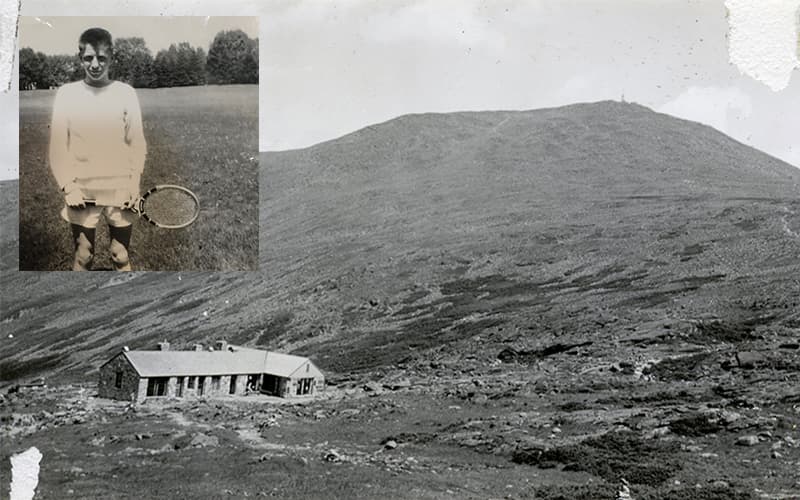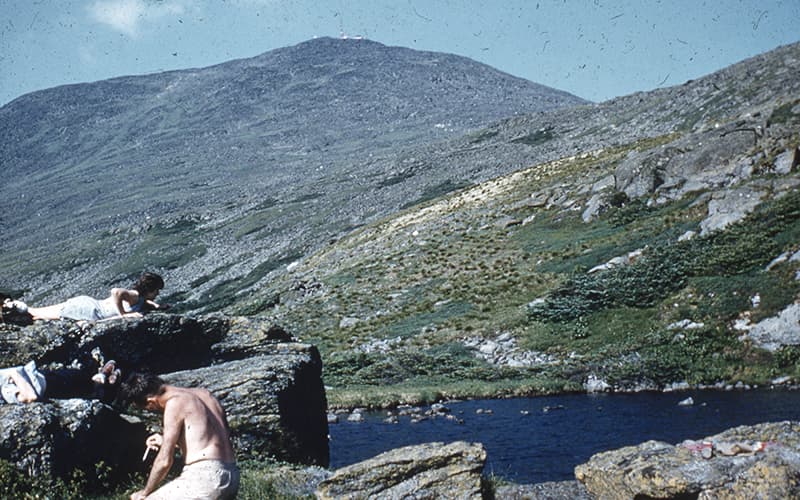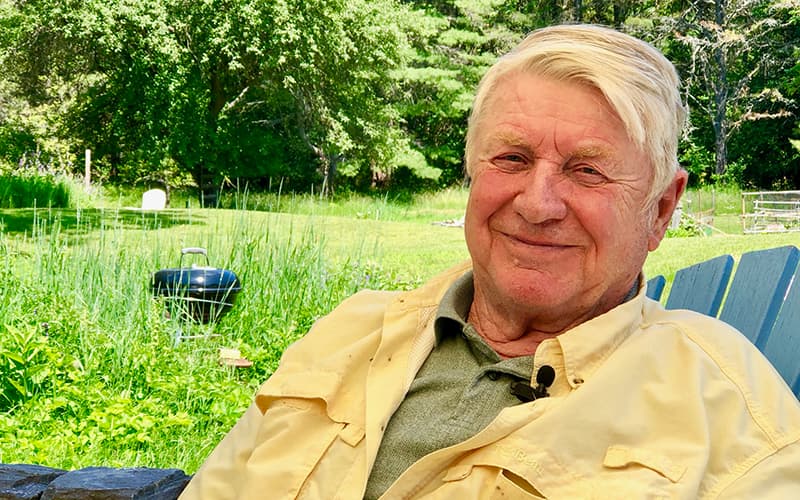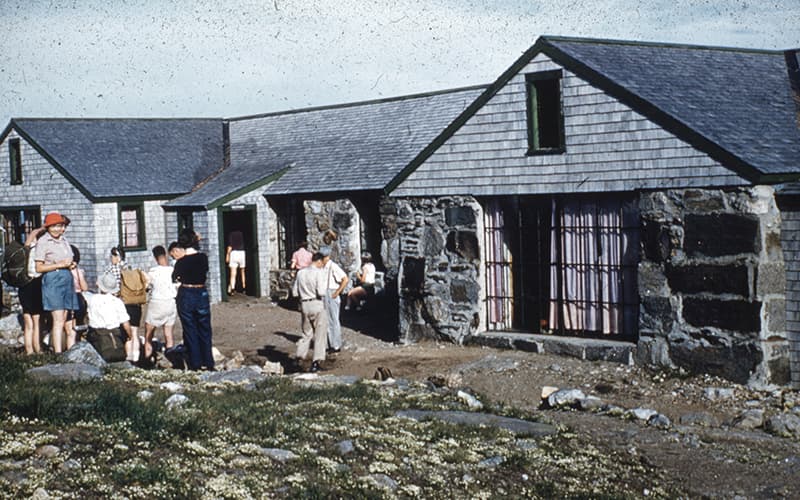V-J Day at 75: A Hiker Recalls a Mount Washington Hike and Return to a War’s End

Mount Washington was feeling benevolent on the afternoon of August 14, 1945, and 14-year-old Hugh Dunphy was taking advantage of the mountain’s good mood.
Dunphy was part of a crew of about 12 campers and counselors from Camp Ropioa in Harrison, Maine, that was hiking toward Washington’s summit under clear skies and mild temperatures—and making excellent time. The boys were packing light—mostly just essentials like water, snacks, and a sleeping bag—and bursting with energy. Even the climb up out of Great Gulf Wilderness along the Great Gulf Trail where the boys had spent the night wasn’t much of a strain.
Tall and lanky with red hair styled in the standard crew cut of the time, Dunphy and his group spent most of their days at the all-boys Camp Ropioa swimming or playing tennis. Sometimes, groups of boys went on multiday hikes outside of camp, much like Dunphy’s 1945 excursion into the White Mountains.
But an even more pressing reality for the Bronxville, N.Y., native was the fact that the world was changing. While at camp just a few days before his Mount Washington adventure, word began circulating that something called an atomic bomb had been dropped on two Japanese cities. The impact of those events just seven and five days before Dunphy’s hike were generally lost on the boys.
“We had no concept of what an atomic bomb was or how much damage it could do,” Dunphy, now 89 and living retired at a farm in West Bath, Maine, recalls. “Initial reports sounded like it was make-believe. No one knew about atomic energy, no one knew about the Manhattan Project.”
What young Dunphy did understand, however, was that the war appeared to be winding down and that meant his older brother, Arthur, might be coming home soon. Just a few months earlier, Arthur—just 22 years old—had survived the devastating Battle of the Bulge, and he was on Dunphy’s mind that afternoon as the clear summit of Mount Washington finally came into view.
Given everything that Dunphy and the country had been through by the time of that August hike, the last thing Dunphy could have prepared for was a sudden burst of loud voices and commotion at Mount Washington’s summit. Only about a quarter-mile away, the boys could see and hear people running frantically and yelling. Dunphy’s counselors, unwilling to take any chances, gathered the boys together in a tight group and began cautiously inching their way to the summit, the commotion up top growing increasingly louder and more chaotic as the team drew near.
“People were running around, acting erratically. But somebody from the top saw us and just ran down the rocks toward us. We prepared for the worst.”
“People were running around, acting erratically,” Dunphy said. “But somebody from the top saw us and just ran down the rocks toward us. We prepared for the worst.”
But much to the surprise of Dunphy and his friends, the frantic messenger from the summit told the boys that word had just come to the top of New England that Japan had surrendered; it was V-J Day (short for “Victory over Japan Day”), and Hugh Dunphy had reached the top of Mount Washington at the very moment celebrations had begun.
“We all just started yelling and screaming,” he said. The war was over. Dunphy’s brother was coming home.
+++

The Mount Washington Dunphy climbed that day was a different mountain from just a few years earlier. The war effort and shortages of gas, metal, food, and other basics had dried up tourism to the North Country. The Cog Railway hadn’t steamed up the mountain in several years, and even the Mount Washington Auto Road was just hanging on, financially.
“I look back at the (auto usage) numbers of some of those years and how they did it is just beyond me,” says Howie Wemyss, the current Mount Washington Auto Road general manager. “The road never closed, but the numbers were really low, like in the hundreds for a whole season. People just weren’t traveling for pleasure.”
Wemyss says that while detailed records of auto road income didn’t begin in earnest until the late 1950s, auto usage of the road increased steadily post-war. Compared to an average of roughly 3,000 cars per season in the 1930s, auto road usage expanded to 6,000 vehicles per year by the 1950s, according to Mount Washington Auto Road data. (Today, 40,000 to 50,000 vehicles make the climb to Washington’s summit each season, the organization says.)
Plus, in the mid-1940s, the auto road’s shuttles of choice, the Ford Woodies, were powering up a mountain road that was still entirely gravel. The road’s current culvert system was not yet in place and crews would occasionally need to build wooden bridge structures to help the Woodies get over erosion ditches.
Two distinct groups of people used the mountain extensively in 1945. The first was the military. Wemyss says he assumes the family that owned the auto road at the time offered the various armed service branches free passage on the road. The first military expedition headed up Mount Washington in March 1942, only a few months after the United States entered the war: a group of scientists from Swarthmore University, working for the Army, tested a Swedish-made primus stove for carbon monoxide fumes inside the closed and frigid shelter of the Mount Washington Observatory.
There were Navy searchlight tests, synthetic rubber tire tests, and tests on new electric blankets, electric flying suits, boots, gloves, and goggles. In the fall of 1943, the U.S. Signal Corps—the information and technology branch of the United States Army—installed at the summit a number of wind recording instruments, which returning service members had brought over from the Arctic. Virtually all the equipment was destroyed before the first day of winter, unable to withstand the brutal Mount Washington gales.
When Dunphy and his team were climbing, it was possible that they ran into one or two commissioned officers from the Climatic Research Section of the Quartermaster Corps of the Army. The group spent the summer of 1945 bivouacked along the auto road from the Cragway to the summit testing scientifically designed wet weather gear for use in extreme hurricane and cloudburst conditions.
Finally, at the summit, Dunphy most certainly would have noticed the research laboratory the B.F. Goodrich Company had constructed to study aircraft icing. The lab was constructed on the back of the Tip-Top House, the old summit hotel, and in operation all year, but winter provided the best opportunity for military scientists to study how high winds and icing affected plane and transport tires.
The other group using the summit was, of course, hikers. Articles from the time in AMC’s Appalachia journal report on the increases in local and regional backpackers. The war got people out of their cars, away from resorts, and on their feet and into tents and mountain huts.
The war got people out of their cars, away from resorts, and on their feet and into tents and mountain huts.
War shortages and a downturn in tourist travel propelled the Appalachian Mountain Club from a small caretaker organization to a powerhouse in outdoor getaway adventure travel. In 1941, according to AMC meeting reports, gross receipts from operation of the club’s White Mountain huts were $49,479 with the total number of visitors sitting at 11,855. By 1945, gross receipts reported stood at $72,555 with 16,419 hikers staying at the huts. The total number of meals served had nearly doubled as well.
Dunphy remembers there being “maybe a couple dozen” people at the summit when he and his friends arrived to join in the victory celebration. But there likely were many more. The Mount Washington Observatory visitor log for August 14, 1945, shows 78 people from 15 different states visited that day. Hugh’s name is not among those listed. He recalls taking a tour of the famed mountaintop weather observatory, but the news and celebration happening outside were too much of a magnet for a teenager to pay much attention to science.
After half an hour of “screaming at the top of our lungs and running around and carrying on,” the counselors managed to wrangle the boys together and head down to Lakes of the Clouds Hut in time for an early supper. The boys ran up Mount Monroe to bag another peak, and then some of them stripped down and jumped into the cool mountain tarn next to the hut.
“The people who ran the hut got upset over that, so they ran out and made us get out,” Dunphy recalls.
But of all the memories Dunphy managed to retain from that day, nearly 75 years later, one curious item sticks out: creamed corn.
+++

Hugh Dunphy and I are sitting out on the patio of his West Bath, Maine, home: a lovely property covered in vegetables and flowers that he calls Ruby Farm. He and his wife, painter Evelyn Dunphy, moved here in the late 1980s. Evelyn sits with us for a while, before leaving for her artist studio, a quaint red cabin that Hugh built called Dried Flowers.
“I’ll leave you boys to your memories,” she says with a smile.
This is an enormous understatement. When it comes to memories, Dunphy can’t remember it all, but those 75 years between the summit and our chat in Maine, reads like a walk-through American history itself. Dunphy went to Bowdoin College, where he majored in economics and was a classmate of former Maine Senator and Senate Majority Leader George Mitchell. Dunphy’s father worked with the original Ditto Corporation, which manufactured the low-cost copy machine. Inspired by his father, Dunphy was one of the original Xerox salesmen and then switched careers to become a salesman for Fisheries Products Ltd. where he was one of the first to suggest cutting the frozen cod filets into prime cuts and long fingers, or fish sticks, to sell to restaurants and hotels around the country. Dunphy’s clients in those days included Arthur Treacher’s Fish and Chips and the Howard Johnson buffet.
Some of that passion for the food industry still exists right in his backyard. We walk through his vegetable garden where each separate lot is named for and dedicated to one of his grandchildren: Molly’s tomatoes and Eli’s beans, to name two.
Dunphy tells me that his 1945 climb of Mount Washington was the only time he hiked the mountain. I learn later, though, that in September 2019, Hugh and Evelyn, along with their two sons, took the Cog Railway up to celebrate their youngest son’s birthday.
I ask him how that one hike was for him, even after all these years.
“I had two brothers in the war, and hearing that the war was over, up in that place…To be up there when all of that happened, well, that was just awe-inspiring.”
He doesn’t hesitate. “It was a wartime economy,” he starts. “I had two brothers in the war, and hearing that the war was over, up in that place…” He trails off, his words failing him for the first time that day. After a few moments of thought, he collects himself.
“To be up there when all of that happened, well, that was just awe-inspiring.”
+++

Landscape can change you; those views, the effort to go to a place few attempt, the way a place like Mount Washington forces you to bond and to reflect. Add into that mix the uncertainty of a world at war, family far from home and a teenager on his own, in a place where anything is possible but nothing is certain, and the trajectory of the rest of Dunphy’s life appears to catapult forward from those two days in the mountains. The boy that climbed that mountain, stayed there. But sometimes, it takes years, or even decades to understand where you come from.
The boys ate, celebrated, breathed that sacred air, and then descended New England’s highest peak that same evening. They went home to a changed world, one of possibility and hope instead of dread and uncertainty.
But to Dunphy, the one memory that stuck, the one revelation from those two days that bubbled to the surface time and time again in our talks was that the boys ate canned creamed corn for dinner that evening up there at Lakes of the Clouds Hut. Dunphy says it was the best creamed corn he ever ate.
“I remember thinking at the time that the [AMC hut croo] couldn’t have picked a heavier meal to carry up to the huts than creamed corn. That is unless they decided to give us stones for dinner.”
“I remember thinking at the time that the [AMC hut croo] couldn’t have picked a heavier meal to carry up to the huts than creamed corn,” he says and laughs. “That is unless they decided to give us stones for dinner.”
Food, effort, the emotional release of the restoration of order. Relief. Dunphy never hiked Mount Washington again because he didn’t have to. The mountain gave him his life and a feeling of connectivity to the greater world—a world no longer at war—that was rare for a man so young.
“I mean, people were doing the same thing all over the world, right—celebrating,” he says as he walks through his garden, a man entering his tenth decade with the easy smile of a teenager. “Times Square or Mount Washington, there was happiness. That’s all.”




